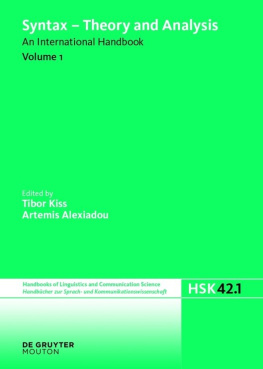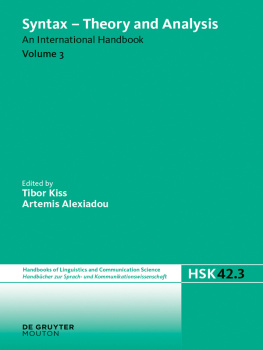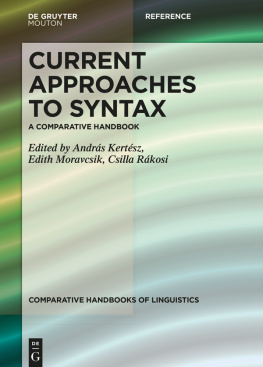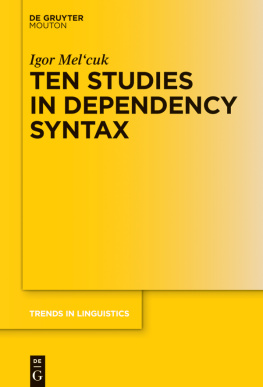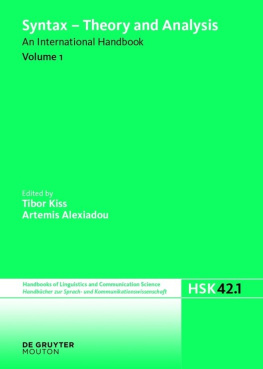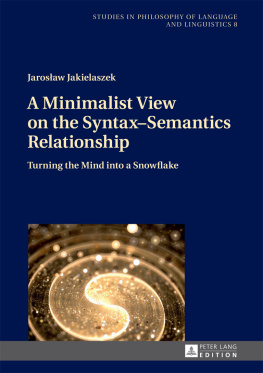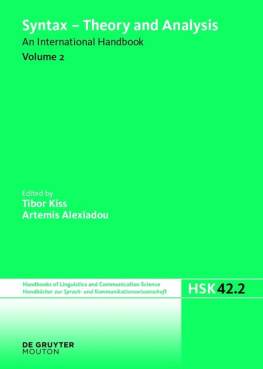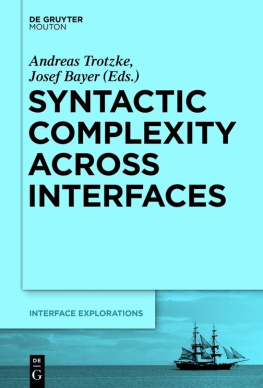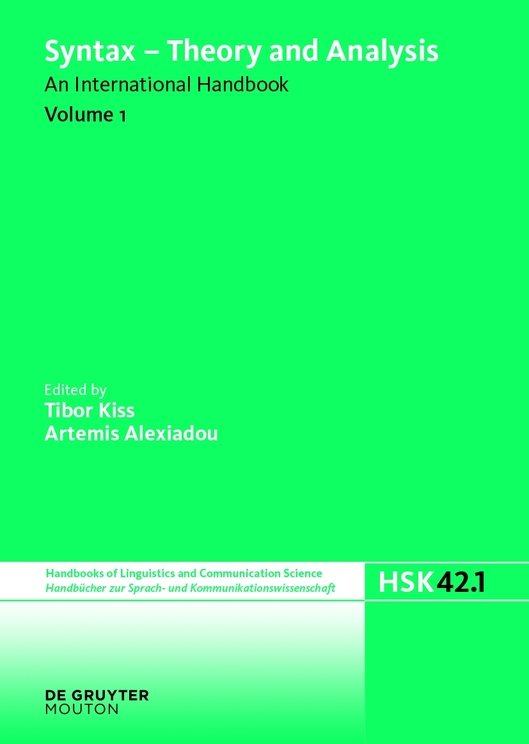This article provides a broad introduction to Syntax, as it is conceived in this handbook. We will present a number of assumptions that have been considered to constitute common ground for all syntacticians. But they are as fundamental as they are controversial for syntactic theory and analysis. In fact, approaches to syntactic analysis as well as syntactic theories quite often take controversial positions, leading to the apparent conclusion that syntactic research is fractured. It is not our goal to offer a band-aid to patch up what better should be kept separate. Our conclusion is that many issues might indeed be controversial within syntactic research but that such controversy should be seen as the driving force behind progress in syntax.
1. Introduction
Perhaps the simplest way to approach syntax is to define it as the linguistic component that relates sound and meaning, and thus fulfils this crucial task in mapping the two intelligible sides of the Saussurean sign. Syntax must thus be able to break up the continuous flow of sound signals into elementary tokens, must be able to provide a structure for the tokens, and enable the semantic component to access the tokens and the larger parts made of them in order to account for the interpretation of complex units. It goes without saying that the same story could be told if we started with the interpretational component, letting syntax map meaning to sound.
A grammar consists of a complex formal unit that requires analysis, a rule system relating atomic and complex units to the complex formal unit under analysis, and a characterization of the atomic or elementary elements, and how they relate to the rule system. Typically, the sentence (S) is the formal unit that requires analysis, there are all kinds of rule systems resulting in a sentence, and the lexical units are taken to be the atomic elements, which are assigned appropriate categories so that the rule system can make use of them. This characterization seems to be uncontroversial, and it owns its uncontroversial status to its relative abstractness, e.g. the lack of detail concerning the rule system, the use of categories, and more or less everything else required to actually carry out a syntactic analysis.
When it comes to detail, however, syntax is mostly conceived as fractured. It is often forgotten that, within the broader realm of Saussurean linguistics, proper syntax started as a straggler, coming to maturity only approximately 60 to 70 years ago, and that it has achieved quite a lot in this short lifetime. And yet, a necessary precondition of syntax seems to be that the linguist becomes a member of one of the many different schools of thought. Schools that sometimes are engaged in fierce fights (giving rise to terms like Linguistics Wars, cf. Harris 1993), and sometimes are content with peaceful coexistence, or mutual neglect. In fact, one realizes soon that schools are partitioned in various dimensions, as for instance formal in opposition to functional or cognitive, formal in opposition to descriptivist, and so forth. Deep within syntax, different views pertain to the structures that are actually used to carve up the continuous flow of sound signals (be they tree structures, dependency arcs, grammatical relations, derivations etc.). This situation may leave those who want to study syntax in a state of confusion, about which school to choose, or whether to choose one at all, or more than one. (In addition to confusion, students may also feel pressured since syntax is interfacial by definition, and hence it will become necessary for the apprentice to be familiar with one of the major components with which syntax interfaces.) It should be noted, however, that disagreement is not pertinent to syntax alone, but can be observed in other areas of linguistics as well (or linguistics as a whole), cf. the discussion following the influential article of Evans and Levinson (2009).
The goal of the present article is twofold: On the one hand, we would like to address several issues that seem to be controversial within syntax as a research area, and shed some light on real or apparent controversies. On the other hand, we would like to make clear that controversy in itself does not mean that a field is unripe or uninteresting, but to the contrary that disagreement is an expression about the relative maturity of syntax. In doing so, we will take recourse to Henk van Riemsdijks presentation of a set of background assumptions which () virtually every linguist () shares (van Riemsdijk 1984: 1).
Writing in 1984, van Riemsdijk believed that the assumptions presented were widely shared. We have chosen a selection from van Riemsdijks assumptions, the ones that we believe to have the strongest bearing on current research. Relating current positions to the positions held back then when van Riemsdijk presented them also allows us to evaluate the progress made in syntax and syntactic theory. In fact, we take controversial issues in syntax to be an indicator of scientific progress. So, it is good that there is controversy.
2. Syntax relates sound and meaning
While the very idea of syntax relating sound and meaning has to be considered uncontroversial, with syntax breaking up the stream of sounds into units which accordingly receive an interpretation, it is at least unclear whether sound and meaning are relevant to syntactic operations or not. Mainstream generative grammar has assumed from Chomsky (1965) onwards that the syntactic component of the grammar is generative (we will come to this term below), while the other components are interpretative, i.e. work on structures provided by syntax. This position has been challenged by a variety of frameworks. HPSG (Pollard and Sag 1994; cf. S. Mller, this volume) assumes that syntactic and semantic properties receive the same formal representation, and interact in agreement and anaphoric binding (the reader is referred to Wagners contribution to this handbook to discuss the relation between syntax and phonology). Pustejovskys generative lexicon (Pustejovsky 1995) raises the question of how syntactic categorization is influenced by lexical semantics to account for coercion processes.
These are just two proposals that challenge a model of syntax, in which syntax is taken to differ fundamentally even from the linguistic components with which it shares an interface (cf. also Mycock, this volume).
3. Sentence grammar differs from extra-sentential (or sub-sentential) modes of combination
Riemsdijk (1984: 2) states that [the structure of the sentence] is determined by rules and principles sui generis. As often when contemplating questions about syntax, the statement seems to be clear and intuitive at the outset, but invites further considerations after second thoughts. What we can assume is that there are sentence internal operations (rules and principles), whose application to units that consist of sentences would be nonsensical, i.e. would not lead to plausible results. Case marking might be a case in point, as well as reference to syntactic arguments or grammatical relations as discourse relations. But the composition of sentences may also rely on rules, which do not exclusively apply within a sentence. Pronominal agreement can serve as an illustration. Consider the examples in (1).

